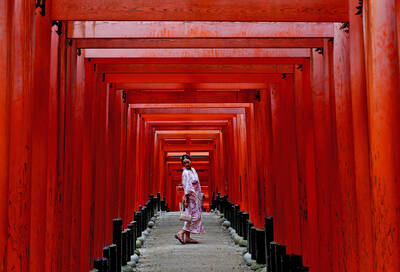At the turn of every year, millions of Brazilians literally pin their hopes on miniature boats that they launch into the ocean.
Loaded with flowers, soaps and bric-a-brac, the white and blue vessels are an offering to the goddess Iemanja, the queen of the sea, who receives their wish lists.
The tougher the times, the more boats that vanish into the waves in the first minutes of the new year.
While holiday sales this year were generally in a slump because of falling incomes and high unemployment, vendors of objects used in Afro-Brazilian cults say sales are booming. Cults such as Candomble and Umbanda worship deities called Orixas, including Iemanja, who have spiritual dominion over elements of nature such as fire and water.
"Out there in the street you can see how activity fell, but here sales are going up," said Rogerio de Brito Ruas, a 33-year-old salesman in a shop called The Kingdom of Exu.
At the entrance stands a statue of Exu, the trickster deity who acts as a messenger between humans and Orixas and is often mistaken for Satan by the uninitiated because of his goatee beard, pointy ears and sly grin.
Loyal customer Edson Pedrosa, 45, added: "Every time people go through a crisis, they tend to seek a religion to be able to sail through the storm ... and the tradition of offerings to Iemanja is beautiful and tempting."
Rio de Janeiro, famous for its beautiful sandy beaches, hosts what city authorities say is the world's biggest party on New Year's Eve. Millions of people, including Iemanja worshippers, take to the beaches.
And it is in Rio that Iemanja commerce has really taken off.
MAGIC SHOPPING MALL
Ruas's shop is one of dozens inside a giant shopping mall in Rio stuffed with cult items.
The size of the "big market of Madureira," as the mall is known, and the many small shops scattered around Rio and other Brazilian cities like Salvador in Bahia state show there is demand for religious and magical items.
The price of the most expensive "offering" kits rarely exceeds US$10 to US$12, including top-of-the-range 1.5m-long boats. The most popular items, such as tiny mirrors, combs or soap for Iemanja to stay beautiful, go for less than US$1, so even the poorest can make a wish.
Giant wooden statues of Orixas cram galleries.
Sequined cloaks and gowns hang in the shop windows along with beautiful headdresses, shiny tin helmets and drums of all sizes. Worshippers can buy those as offerings to the deities or as gifts for the priests.
Chickens, geese, goats and lambs can be bought for sacrifice. "Sacrifice is part of the religion, but how is it different from the meat consumed daily around the world?" said Pedrosa. "We only leave small sacred bits for the religious needs, the rest gets cooked and eaten in the normal way."
BROUGHT BY SLAVES
Although Brazil is the world's biggest Roman Catholic country with more than 70 percent of the 175 million population describing themselves as Catholics, the Afro-Brazilian cults have millions of followers, including many devoted Catholics.
Candomble has its roots in the African religious traditions brought to Brazil by millions of slaves under Portuguese rule.
In Brazil, the religion mutated, influenced by Christianity and by religious and medicinal practices of indigenous Indians.
Barred from practicing their religion, slaves brought the images of many Christian saints into the cult, which has one supreme god, Olorum, and is generally considered monotheistic despite having other powerful deities.
Thus, Jesus Christ is often associated with Oxala -- the most respected of all Orixas, while Iemanja and Virgin Mary are often identified as the same.
Candomble worships its Orixas as forces of nature that produce energy, or force, known as Axe.
Priests cast shells to decide which Orixa will guide a new follower through life.
In Umbanda, archetypal spirits, including people who once lived, are in high esteem and priests consult them while in a trance, achieved by dancing to rhythmic music. Orixas are also worshipped, but are not invoked as in Candomble.
"Magic and miracles are also part of our cult," said Jose, a diminutive 58-year-old priest dressed in shorts and a soccer T-shirt.
"But they are miracles that normally come from within the person. As for the magic, it is only white. There is no evil here."

Seven hundred job applications. One interview. Marco Mascaro arrived in Taiwan last year with a PhD in engineering physics and years of experience at a European research center. He thought his Gold Card would guarantee him a foothold in Taiwan’s job market. “It’s marketed as if Taiwan really needs you,” the 33-year-old Italian says. “The reality is that companies here don’t really need us.” The Employment Gold Card was designed to fix Taiwan’s labor shortage by offering foreign professionals a combined resident visa and open work permit valid for three years. But for many, like Mascaro, the welcome mat ends at the door. A

The Western media once again enthusiastically forwarded Beijing’s talking points on Japanese Prime Minister Sanae Takaichi’s comment two weeks ago that an attack by the People’s Republic of China (PRC) on Taiwan was an existential threat to Japan and would trigger Japanese military intervention in defense of Taiwan. The predictable reach for clickbait meant that a string of teachable moments was lost, “like tears in the rain.” Again. The Economist led the way, assigning the blame to the victim. “Takaichi Sanae was bound to rile China sooner rather than later,” the magazine asserted. It then explained: “Japan’s new prime minister is

NOV. 24 to NOV. 30 It wasn’t famine, disaster or war that drove the people of Soansai to flee their homeland, but a blanket-stealing demon. At least that’s how Poan Yu-pie (潘有秘), a resident of the Indigenous settlement of Kipatauw in what is today Taipei’s Beitou District (北投), told it to Japanese anthropologist Kanori Ino in 1897. Unable to sleep out of fear, the villagers built a raft large enough to fit everyone and set sail. They drifted for days before arriving at what is now Shenao Port (深奧) on Taiwan’s north coast,

Divadlo feels like your warm neighborhood slice of home — even if you’ve only ever spent a few days in Prague, like myself. A projector is screening retro animations by Czech director Karel Zeman, the shelves are lined with books and vinyl, and the owner will sit with you to share stories over a glass of pear brandy. The food is also fantastic, not just a new cultural experience but filled with nostalgia, recipes from home and laden with soul-warming carbs, perfect as the weather turns chilly. A Prague native, Kaio Picha has been in Taipei for 13 years and